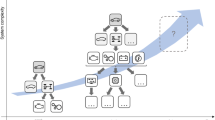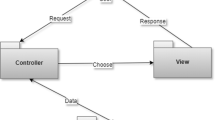Abstract
Model-Driven Architecture (MDA) supports the transformation from reusable models to executable software. Business representations, however, cannot be fully and explicitly represented in such models for direct transformation into running systems. Thus, once business needs change, the language abstractions used by MDA (e.g. object constraint language/action semantics), being low level, have to be edited directly. We therefore describe an agent-oriented MDA (AMDA) that uses a set of business models under continuous maintenance by business people, reflecting the current business needs and being associated with adaptive agents that interpret the captured knowledge to behave dynamically. Three contributions of the AMDA approach are identified: (1) to Agent-oriented Software Engineering, a method of building adaptive Multi-Agent Systems; (2) to MDA, a means of abstracting high-level business-oriented models to align executable systems with their requirements at runtime; (3) to distributed systems, the interoperability of disparate components and services via the agent abstraction.


















Similar content being viewed by others
References
Auml Web Site. http://www.auml.org/.
Bruns R, Dunkel J and Ossowski S (2005) Advisory agents in the semantic web. In Proceedings of the Seventh International Conference on Enterprise Information Systems, pp 271–278. INSTICC, Setúbal, Portugal.
Damian D (2007) Stakeholders in global requirements engineering: lessons learned from practice. IEEE Software 24 (2), 21–27.
Ehrler L and Cranefield S (2004) Executing agent UML diagrams. In Proceedings of the Third International Joint Conference on Autonomous Agents and Multiagent Systems, pp 906–913, IEEE Computer Society, Washington, DC, USA.
Fiadeiro JL (2007) Designing for software's social complexity. IEEE Computer 40 (1), 34–39.
Fowler M (2004) UML Distilled: A Brief Guide to the Standard Object Modeling Language (3rd edn). Addison-Wesley, Boston, MA.
Foundation for Intelligent Physical Agents. http://www.fipa.org/.
France R, Ghosh S and Trong T (2006) Model-driven development using UML 2.0: promises and pitfalls. IEEE Computer 39 (2), 59–66.
Jade Platform. http://jade.tilab.com/.
Kleppe A, Warmer J and Bast W (2003) MDA Explained: The Model Driven Architecture: Practice and Promise. Addison-Wesley, Boston, MA.
McLaughlin B (2002) Java & XML Data Binding. O'Reilly, California.
Mellor S and Balcer M (2002) Executable UML: A Foundation for Model Driven Architecture. Addison-Wesley, Boston, MA.
Meservy T and Fenstermacher K (2005) Transforming software development: an MDA road map. IEEE Computer 38 (9), 52–58.
Object Management Group. 250 First Ave. Suite 100, Needham, MA 02494, USA.
Object Management Group (2002a) CORBA 3.0 – IDL Syntax and Semantics chapter. OMG document formal/02-06-07, USA.
Object Management Group (2002b) OMG Unified Modeling Language Specification (Action Semantics). OMG document ptc/02-01-09, USA.
Riehle D and Perry A (2002) Framework Design and Implementation with Java and UML. Tutorials at OOPSLA.
Schmidt DC (2006) Model-driven engineering. IEEE Computer 39 (2), 25–31.
Wooldridge M, Jennings NR and Kinny D (1999) A methodology for agent-oriented analysis and design. In Proceedings of the third International Conference on Autonomous Agents, pp 69–76, ACM Press, New York, NY, USA.
Xiao L and Greer D (2005) The adaptive agent model: software adaptivity through dynamic agents and XML-based business rules. In Proceedings of the 17th International Conference on Software Engineering and Knowledge Engineering, pp 62–67, Knowledge Systems Institute, Skokie, Illinois, USA.
Xiao L and Greer D (2006a) Externalisation and adaptation of multi-agent system behaviour. In Advanced Topics in Database Research, Volume 5 (SIAU K, Ed), pp 148–169, IGI Publishing, Hershey, PA.
Xiao L and Greer D (2006b) The agent–rule–class framework for multi-agent systems. International Journal of Multiagent and Grid Systems 2 (4), 325–351, IOS Press, Amsterdam, The Netherlands.
Author information
Authors and Affiliations
Corresponding author
Rights and permissions
About this article
Cite this article
Xiao, L., Greer, D. Towards agent-oriented model-driven architecture. Eur J Inf Syst 16, 390–406 (2007). https://doi.org/10.1057/palgrave.ejis.3000688
Received:
Revised:
Accepted:
Published:
Issue Date:
DOI: https://doi.org/10.1057/palgrave.ejis.3000688




